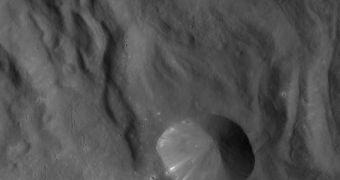The NASA Dawn space probe has descended into a new science orbit around Vesta, the largest asteroid in our solar system. The spacecraft is currently in its second of four planned orbits. After completing studies from all these locations, it will depart for the dwarf planet Ceres in mid-2012.
Mission controllers at the NASA Jet Propulsion Laboratory (JPL) are proud to report that the orbital transfer maneuver went as planned. The move was completed on Thursday, September 29, when the probe sent back its first images from its new orbital vantage point.
Its current path is called the high altitude mapping orbit (HAMO), and is the second one it occupies since first arriving at Vesta, in July 2011. HAMO is 4 times lower than the previous survey orbit, reaching as far down as 420 miles (680 kilometers) above the large asteroid's surface.
While Dawn flies over the asteroid's dayside, its sensitive suite of scientific instruments will be collecting a wide variety of data. As the probe moves over the nightside, it will relay these information back to JPL scientists, in Pasadena, California.
According to experts, HAMO represents the most critical step of the Vesta stage of Dawn's mission. It is the most important orbit, and has the potential to provide the highest scientific returns if exploited properly. During its stay here, the probe will need to fulfill three main objectives.
The first and most viral is mapping the illuminated surfaces of the asteroid in colors. Another instrument will have to provide stereo (3D) images of various landscape features on Vesta, while the third main science goal is to acquire visible and infrared mapping spectrometer data.
In addition, the space probe will also have to conduct a series of radio experiments to assess the asteroid's gravitational pull. JPL experts are experimented in this maneuver, since they've carried it out with the Cassini orbiter around Saturn's largest moon, Titan.
Knowing how Vesta's gravity is distributed will go a long way towards understanding the asteroid's inner structure. In turn, this is very important for gaining new insights into how the solar system formed in its current configuration.
“Perhaps the most notable difference in the new orbit is the frequency with which Dawn circles Vesta. In survey orbit, it took Dawn three days to make its way around the asteroid. Now in HAMO, the spacecraft completes the same task in a little over 12 hours,” a JPL press release reports.
“HAMO is scheduled to last about 30 Earth days, during which Dawn will circle Vesta more than 60 times. For about 10 of those 30 days, Dawn will peer straight down at the exotic landscape below it during the dayside passages. For about 20 days, the spacecraft will view the surface at multiple angles,” it concludes.

 14 DAY TRIAL //
14 DAY TRIAL //